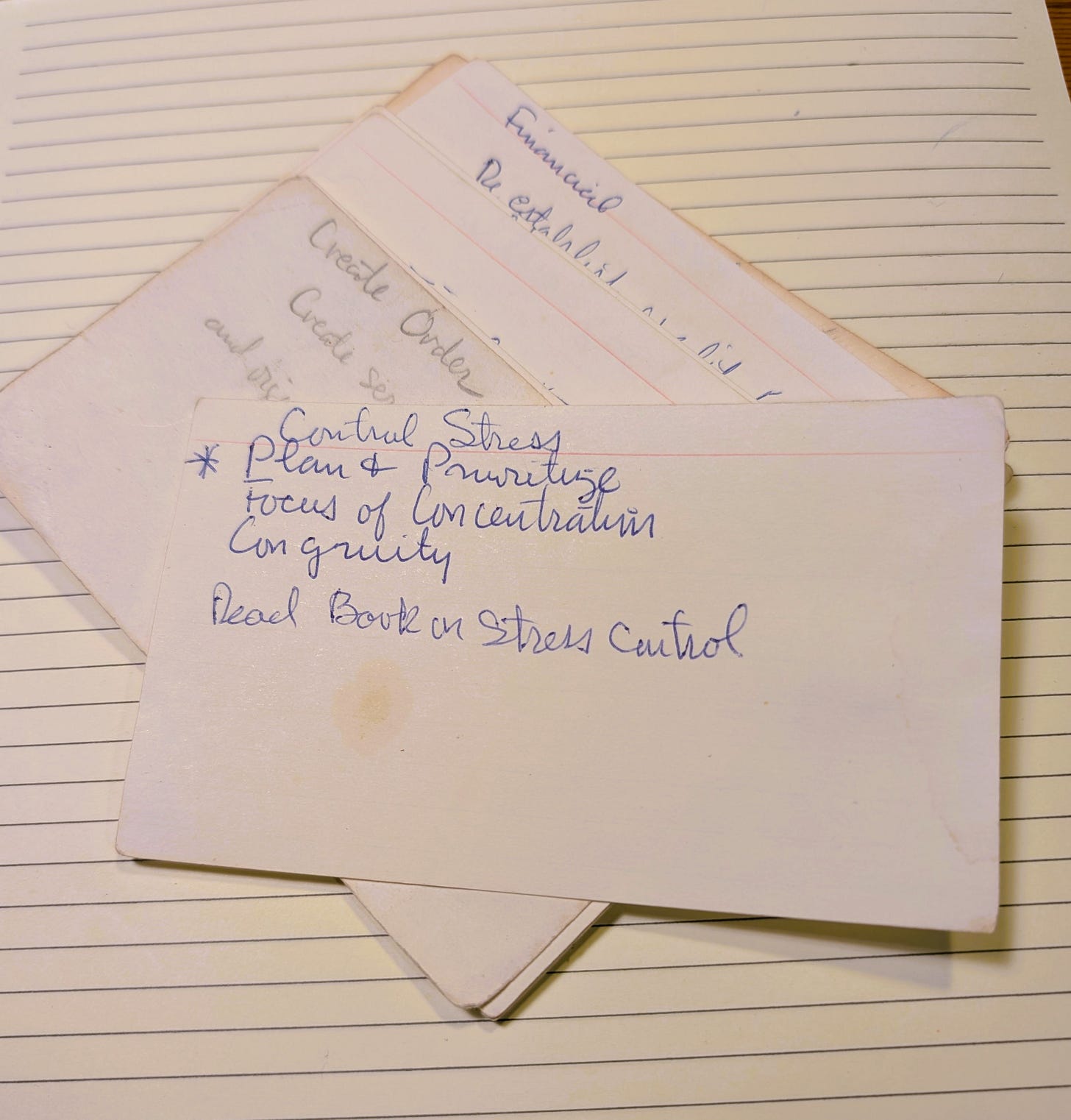Paper. Paper? Paper!
My quest involves a long search to try to see what’s in the cards
In my previous missive, I talked about my failings in organizing myself, describing my numerous false starts in my efforts to “Get Organized.” You can see it here.
Throughout my long, disorganized life, cards have played a part—a minor role, for the most part—but they have been around. I’ve taken note of them and worked with them.
In my last message, I talked about finding a small stack of 3x5 cards I used in a goal-setting/planning exercise. The process didn’t work for me, but the cards persisted. Through at least two major relocations and a couple of jobs, the cards just bobbed along in my wake, a bit of detritus that I didn’t use but apparently could not let go of.
Calling Cards
When I started calling dances in the mid 1990s, one of the first things that struck me was the fact that callers used little cards—3x5s usually—as crib sheets. They keep little card file boxes, with cards for all the dances they called. Periodically, frantic messages would appear on dance caller listserves: “Help, I lost (or forgot) my cards.”
Most contra dance callers, while calling, held a card up in front of them and used it to remind them of the dance figures. In fact, many callers had their eyes glued to cards and forgot to pay attention to what was going on out on the dance floor.
ASIDE: The same problem persists, although now it’s likely the caller will be holding a phone up and reading from it instead of focusing on the dancers, the music, and all that other good stuff.
I had two responses to all this.
I was used to doing song-leading. I never used cards, notes, or anything; good song leaders, I thought, had the words by heart. No paper required. So I tended to look down on the idea that callers needed these little bits of paper. I could remember all the lyrics of a song. Remember a handful of figures for a dance? C’mon, you should be able to handle that in your head, right?
And yet, as someone who forgot a word from time to time or struggled to pick up a new song, the idea of having everything on paper so you didn’t have to worry about remembering everything—that seemed kind of nice.
So, me being me, I devised my own system for recording dances on cards.
First, I used bigger cards—4x6 size. I had found some small photo albums—tiny two-ring binders—that held 4x6 photos in sleeves. I wrote out the dances with all the detailed instructions on a card. Then I created an abbreviated set of calls, wrote them with a black sharpie, and slipped that card into the sleeve so that the second card was visible in the back.
So—one “card” (the sleeve) with details in front and the abbreviated cues on the back, written so large that I could put it on the floor and still read it if I needed to refresh my memory.
Pretty clever, I thought.
In use, this system broke down for me. I was good at picking dances and pulling the cards out of their little binder, but I was bad at putting them back in the binders and generally organizing them. After a few years, I found that I just had a big mess of cards, with dances I used a lot on top and everything else in a pile.
At some point, frustrated with myself, I keyed everything into a computer and produced a book with just the dance instructions. It has a table of contents. The dances are always in the same order and relatively easy to find. Of course, many callers are using laptops or their phones, now.
The Kleon Effect
About ten years ago, when I started reading the Austin Kleon books, I decided I needed to carry a notebook. All artists and writers carry notebooks and sketchbooks with them, right? You need to be ready to capture that fleeting thought or image, save it, and recall it.
I tried various notebooks. I’d keep one with me for a while and make a few notes, but it would disappear at some point, and I didn’t really miss it.
I struggled with the problem that when you make a note in a notebook, you theoretically need to have a way to do something with it. So, add it to another list? Transcribe it somewhere? My clip-together notebook didn’t really work for me, but it had an interesting characteristic. I could pull a card out with a note on it and use the single card as a reminder—or something.
Grid Cards
At some point in 2024, I bought some 3x5 cards that were gridded instead of lined. I liked them, mainly because I was deeply involved in the construction project at the time. The grid made it easy to do simple diagrams, floor plans, and other construction doodles. A grid card has a built-in scale rule. I could easily see when things fit or didn’t fit—or if I would have to plan and measure carefully if they were going to fit—whatever it was.
The situation at the end of 2024 was like this.
I was using lots of 3x5 cards to make notes and little construction drawings.
I was amassing big piles of cards with notes, but they were not in any kind of proper order.
I was searching for some way to organize my life better so I could get more stuff done.
Sometime toward the end of December, I made a card that I intended as a kind of To Do list.
That card marked the beginning of a new phase in my quest.
Anon.
Ridge





